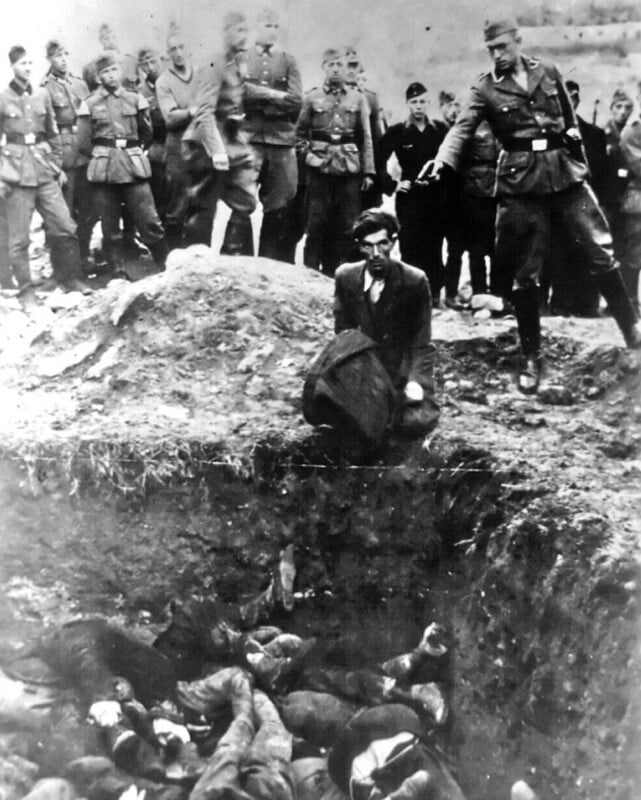Historian Finally Identifies Nazi in Infamous Holocaust Photo Using AI

One of the most horrifying photographs depicting the Holocaust taking place in an occupied part of the Soviet Union during World War II has been properly identified thanks to years of research and the help of artificial intelligence.
The visceral photograph, ‘The Last Jew in Vinnitsa’, depicts a member of the Nazi SS with his gun pointing at the head of a Ukrainian Jew. He is crouching on the edge of a mass grave filled with bodies.
Warning: The full photo is further down this page and is upsetting.
The photograph was first circulated in 1961 by the United Press. It came from Holocaust survivor Al Moss, who handed it to the news agency during the trial of SS officer Adolf Eichmann. Moss wanted the world to know “what went on in Eichmann’s time.”
However, little was known about the photo. ‘The Last Jew in Vinnitsa’ was apparently written on the reverse side of the photograph, and that became the photo’s name. But new research reveals that the photo was almost certainly taken 55 miles away in the citadel of Berdychiv, a historic Ukrainian city that was once a center of Jewish life.
US-based German historian Jürgen Matthäus has spent years trying to hunt down the provenance of the photo and the identities of the people shown. His work, recently published in the Zeitschrift für Geschichtswissenschaft (Journal of Historical Studies), finds that the photo was taken on June 28, 1941, and the SS soldier holding the gun is a former French and English teacher, Jakobus Onnen.

Lucky Breaks, Thorough Research, and Artificial Intelligence
The Guardian reports that Matthäus managed to identify the date, location, and unit by digging through “dusty archives, lucky breaks, input from peers,” and the involvement of open-source journalism outfit Bellingcat.
Matthäus shared some of his preliminary research, which attracted media coverage in Germany. Then, a man came forward who said he believed that the shooter was his wife’s uncle, Jakobus Onnen. Her family still had photos of Onnen, which apparently bear striking similarities.
These photos were then analyzed via an AI, which gave an “unusually high” match.
“The AI experts tell me that this being a historical photo makes it more difficult to arrive at a 98 or 99.9% [match]” as often yielded in contemporary forensic work,” Matthäus tells The Guardian. “Digital tools in the humanities have massively increased in use, but it’s usually for the processing of mass data, not so much for qualitative analysis.”
Matthäus believes that Onnen is the SS soldier, but what troubles him is that he doesn’t know what motivated him to pose in such a terrible way. Onnen’s family did have correspondence from him from the Eastern Front — but they destroyed the letters in the 1990s.
“Motivation is one of the most difficult questions to answer. The reason I think why he is posing there, the way he depicts himself — I think is meant to impress,” Matthäus tells The Guardian. “Participating in a killing like that was taken for granted and didn’t give you any kind of bonus points in these murder units.”
The identity of the victim, nor the photographer who took the image, has been found. Hundreds of thousands of Jews died anonymously in what is now Ukraine.